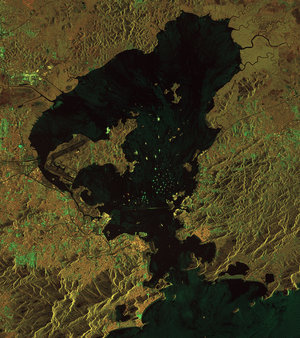Accept all cookies Accept only essential cookies See our Cookie Notice

About ESA
The European Space Agency (ESA) is Europe’s gateway to space. Its mission is to shape the development of Europe’s space capability and ensure that investment in space continues to deliver benefits to the citizens of Europe and the world.
Highlights
ESA - United space in Europe
This is ESA ESA facts Member States & Cooperating States Funding Director General Top management For Member State Delegations European vision European Space Policy ESA & EU Space Councils Responsibility & Sustainability Annual Report Calendar of meetings Corporate newsEstablishments & sites
ESA Headquarters ESA ESTEC ESA ESOC ESA ESRIN ESA EAC ESA ESAC Europe's Spaceport ESA ESEC ESA ECSAT Brussels Office Washington OfficeWorking with ESA
Business with ESA ESA Commercialisation Gateway Law at ESA Careers Cyber resilience at ESA IT at ESA Newsroom Partnerships Merchandising Licence Education Open Space Innovation Platform Integrity and Reporting Administrative Tribunal Health and SafetyMore about ESA
History ESA Historical Archives Exhibitions Publications Art & Culture ESA Merchandise Kids Diversity ESA Brand Centre ESA ChampionsSpace in Member States
Find out more about space activities in our 23 Member States, and understand how ESA works together with their national agencies, institutions and organisations.
Science & Exploration
Exploring our Solar System and unlocking the secrets of the Universe
Go to topicAstronauts
Missions
Juice Euclid Webb Solar Orbiter BepiColombo Gaia ExoMars Cheops Exoplanet missions More missionsActivities
International Space Station Orion service module Gateway Concordia Caves & Pangaea BenefitsLatest
Space Safety
Protecting life and infrastructure on Earth and in orbit
Go to topicAsteroids
Asteroids and Planetary Defence Asteroid danger explained Flyeye telescope: asteroid detection Hera mission: asteroid deflection Near-Earth Object Coordination CentreSpace junk
About space debris Space debris by the numbers Space Environment Report In space refuelling, refurbishing and removingSafety from space
Clean Space ecodesign Zero Debris Technologies Space for Earth Supporting Sustainable DevelopmentApplications
Using space to benefit citizens and meet future challenges on Earth
Go to topicObserving the Earth
Observing the Earth Future EO Copernicus Meteorology Space for our climate Satellite missionsCommercialisation
ESA Commercialisation Gateway Open Space Innovation Platform Business Incubation ESA Space SolutionsLatest
Enabling & Support
Making space accessible and developing the technologies for the future
Go to topicBuilding missions
Space Engineering and Technology Test centre Laboratories Concurrent Design Facility Preparing for the future Shaping the Future Discovery and Preparation Advanced Concepts TeamSpace transportation
Space Transportation Ariane Vega Space Rider Future space transportation Boost! Europe's Spaceport Launches from Europe's Spaceport from 2012Latest
Earth from Space: São Paulo, Brazil
Thank you for liking
You have already liked this page, you can only like it once!
This radar image from Copernicus Sentinel-1 shows the city of São Paulo and part of the homonymous state in southeast Brazil.
Zoom in to explore this image at its full resolution or click on the circles to learn more.
While standard radar images are usually black and white, this composite image combines three separate radar acquisitions, each assigned to a specific colour, so that the resulting colours show changes in land and water occurred between acquisitions. Areas in grey depict little or no change.
The first image, captured on 1 December 2022, is assigned to the blue channel; the second, from 6 January 2023, to green; and the third, from 11 February 2023, to red.
Radar data are interpreted by studying the intensity of the backscattered radar signal.
Water surfaces reflect the radar signal away from the satellite which makes water bodies appear dark, such as the Billings reservoir visible near the southern outskirts of the city.
In certain water bodies, such as the Represa do Jaguari reservoir at the top of the image, the shores have different coloured outlines owing to the changing level of the water.
Urban areas appear white as cities reflect radar extremely well. The brightest areas in the image represent the most densely built.
São Paulo, the capital of São Paulo state, is visible as the large, bright area in the centre-left of the image. This huge sprawling metropolis has an area of nearly 1500 sq km and a population of over 10 million, making it the most populous city in South America.
São Paulo is situated on a plateau extending behind the Serra do Mar mountain range, which can be seen running along the Atlantic coast. São Paulo’s port, Santos, lies 50 km southeast of the city on the São Vicente Island, separated from the mainland by a tidal channel.
Ships heading to or leaving the port of Santos appear as shining, coloured dots off the coast. Their colours depend on the date the images were acquired. Changes in the water, caused by surface currents and waves, can be seen as different shades in the Atlantic Ocean.
-
CREDIT
contains modified Copernicus Sentinel data (2022-23), processed by ESA -
LICENCE
ESA Standard Licence and Additional permission may be required
(contact spaceinimages@esa.int for further information)

Aerosols over São Paulo

Rio de Janeiro, Brazil

Marajó, Brazil

Central-eastern Brazil















 Germany
Germany
 Austria
Austria
 Belgium
Belgium
 Denmark
Denmark
 Spain
Spain
 Estonia
Estonia
 Finland
Finland
 France
France
 Greece
Greece
 Hungary
Hungary
 Ireland
Ireland
 Italy
Italy
 Luxembourg
Luxembourg
 Norway
Norway
 The Netherlands
The Netherlands
 Poland
Poland
 Portugal
Portugal
 Czechia
Czechia
 Romania
Romania
 United Kingdom
United Kingdom
 Slovenia
Slovenia
 Sweden
Sweden
 Switzerland
Switzerland
























